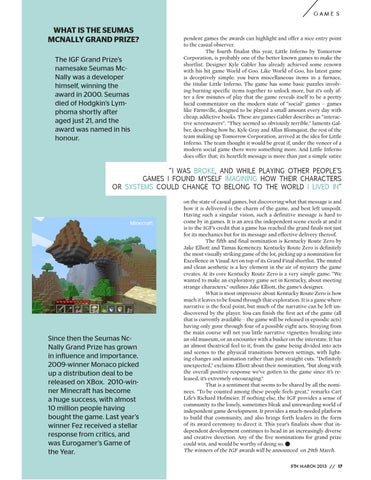GAMES
WHAT IS THE SEUMAS MCNALLY GRAND PRIZE? The IGF Grand Prize’s namesake Seumas McNally was a developer himself, winning the award in 2000. Seumas died of Hodgkin’s Lymphoma shortly after aged just 21, and the award was named in his honour.
pendent games the awards can highlight and offer a nice entry point to the casual observer. The fourth finalist this year, Little Inferno by Tomorrow Corporation, is probably one of the better known games to make the shortlist. Designer Kyle Gabler has already achieved some renown with his hit game World of Goo. Like World of Goo, his latest game is deceptively simple: you burn miscellaneous items in a furnace, the titular Little Inferno. The game has some basic puzzles involving burning specific items together to unlock more, but it’s only after a few minutes of play that the game reveals itself to be a pretty lucid commentator on the modern state of “social” games – games like Farmville, designed to be played a small amount every day with cheap, addictive hooks. These are games Gabler describes as “interactive screensavers”. “They seemed so obviously terrible,” laments Galber, describing how he, Kyle Gray and Allan Blomquist, the rest of the team making up Tomorrow Corporation, arrived at the idea for Little Inferno. The team thought it would be great if, under the veneer of a modern social game there were something more. And Little Inferno does offer that; its heartfelt message is more than just a simple satire
“I WAS BROKE, AND WHILE PLAYING OTHER PEOPLE’S GAMES I FOUND MYSELF IMAGINING HOW THEIR CHARACTERS OR SYSTEMS COULD CHANGE TO BELONG TO THE WORLD I LIVED IN”
Minecraft
Since then the Seumas NcNally Grand Prize has grown in influence and importance. 2009-winner Monaco picked up a distribution deal to be released on XBox. 2010-winner Minecraft has become a huge success, with almost 10 million people having bought the game. Last year’s winner Fez received a stellar response from critics, and was Eurogamer’s Game of the Year.
on the state of casual games, but discovering what that message is and how it is delivered is the charm of the game, and best left unspoilt. Having such a singular vision, such a definitive message is hard to come by in games. It is an area the independent scene excels at and it is to the IGF’s credit that a game has reached the grand finals not just for its mechanics but for its message and effective delivery thereof. The fifth and final nomination is Kentucky Route Zero by Jake Elliott and Tamas Kemenczy. Kentucky Route Zero is definitely the most visually striking game of the lot, picking up a nomination for Excellence in Visual Art on top of its Grand Final shortlist. The muted and clean aesthetic is a key element in the air of mystery the game creates. At its core Kentucky Route Zero is a very simple game. “We wanted to make an exploratory game set in Kentucky, about meeting strange characters,” outlines Jake Elliott, the game’s designer. What is most impressive about Kentucky Route Zero is how much it leaves to be found through that exploration. It is a game where narrative is the focal point, but much of the narrative can be left undiscovered by the player. You can finish the first act of the game (all that is currently available – the game will be released in episodic acts) having only gone through four of a possible eight acts. Straying from the main course will net you little narrative vignettes: breaking into an old museum, or an encounter with a busker on the interstate. It has an almost theatrical feel to it, from the game being divided into acts and scenes to the physical transitions between settings, with lighting changes and animation rather than just straight cuts. “Definitely unexpected,” exclaims Elliott about their nomination, “but along with the overall positive response we’ve gotten to the game since it’s released, it’s extremely encouraging.” That is a sentiment that seems to be shared by all the nominees. “To be counted among these people feels great,” remarks Cart Life’s Richard Hofmeier. If nothing else, the IGF provides a sense of community to the lonely, sometimes bleak and unrewarding world of independent game development. It provides a much-needed platform to build that community, and also brings forth leaders in the form of its award ceremony to direct it. This year’s finalists show that independent development continues to head in an increasingly diverse and creative direction. Any of the five nominations for grand prize could win, and would be worthy of doing so. The winners of the IGF awards will be announced on 29th March. 5TH MARCH 2013 // 17
